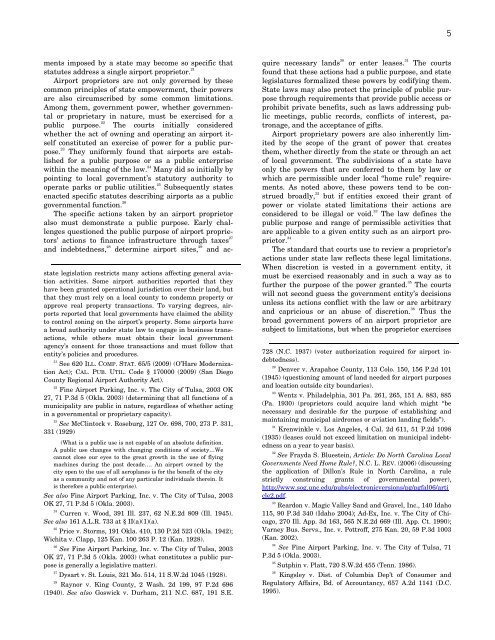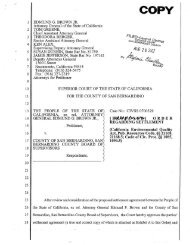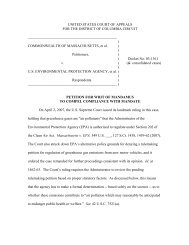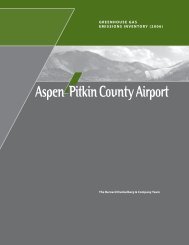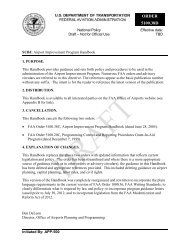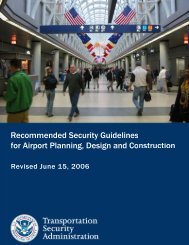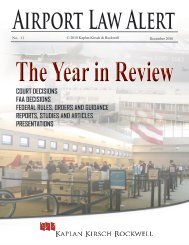ACRP Legal Research Digest 10
ACRP Legal Research Digest 10
ACRP Legal Research Digest 10
Create successful ePaper yourself
Turn your PDF publications into a flip-book with our unique Google optimized e-Paper software.
5<br />
ments imposed by a state may become so specific that<br />
statutes address a single airport proprietor. 21<br />
Airport proprietors are not only governed by these<br />
common principles of state empowerment, their powers<br />
are also circumscribed by some common limitations.<br />
Among them, government power, whether governmental<br />
or proprietary in nature, must be exercised for a<br />
public purpose. 22 The courts initially considered<br />
whether the act of owning and operating an airport itself<br />
constituted an exercise of power for a public purpose.<br />
23<br />
They uniformly found that airports are established<br />
for a public purpose or as a public enterprise<br />
within the meaning of the law. 24 Many did so initially by<br />
pointing to local government’s statutory authority to<br />
operate parks or public utilities. 25<br />
Subsequently states<br />
enacted specific statutes describing airports as a public<br />
governmental function. 26<br />
The specific actions taken by an airport proprietor<br />
also must demonstrate a public purpose. Early challenges<br />
questioned the public purpose of airport proprietors’<br />
actions to finance infrastructure through taxes 27<br />
and indebtedness, 28 determine airport sites, 29 and acstate<br />
legislation restricts many actions affecting general aviation<br />
activities. Some airport authorities reported that they<br />
have been granted operational jurisdiction over their land, but<br />
that they must rely on a local county to condemn property or<br />
approve real property transactions. To varying degrees, airports<br />
reported that local governments have claimed the ability<br />
to control zoning on the airport’s property. Some airports have<br />
a broad authority under state law to engage in business transactions,<br />
while others must obtain their local government<br />
agency’s consent for those transactions and must follow that<br />
entity’s policies and procedures.<br />
21<br />
See 620 ILL. COMP. STAT. 65/5 (2009) (O’Hare Modernization<br />
Act); CAL. PUB. UTIL. Code § 170000 (2009) (San Diego<br />
County Regional Airport Authority Act).<br />
22<br />
Fine Airport Parking, Inc. v. The City of Tulsa, 2003 OK<br />
27, 71 P.3d 5 (Okla. 2003) (determining that all functions of a<br />
municipality are public in nature, regardless of whether acting<br />
in a governmental or proprietary capacity).<br />
23<br />
See McClintock v. Roseburg, 127 Or. 698, 700, 273 P. 331,<br />
331 (1929)<br />
(What is a public use is not capable of an absolute definition.<br />
A public use changes with changing conditions of society…We<br />
cannot close our eyes to the great growth in the use of flying<br />
machines during the past decade…. An airport owned by the<br />
city open to the use of all aeroplanes is for the benefit of the city<br />
as a community and not of any particular individuals therein. It<br />
is therefore a public enterprise).<br />
See also Fine Airport Parking, Inc. v. The City of Tulsa, 2003<br />
OK 27, 71 P.3d 5 (Okla. 2003).<br />
24<br />
Curren v. Wood, 391 Ill. 237, 62 N.E.2d 809 (Ill. 1945).<br />
See also 161 A.L.R. 733 at § II(a)(1)(a).<br />
25<br />
Price v. Storms, 191 Okla. 4<strong>10</strong>, 130 P.2d 523 (Okla. 1942);<br />
Wichita v. Clapp, 125 Kan. <strong>10</strong>0 263 P. 12 (Kan. 1928).<br />
26<br />
See Fine Airport Parking, Inc. v. The City of Tulsa, 2003<br />
OK 27, 71 P.3d 5 (Okla. 2003) (what constitutes a public purpose<br />
is generally a legislative matter).<br />
27<br />
Dysart v. St. Louis, 321 Mo. 514, 11 S.W.2d <strong>10</strong>45 (1928).<br />
28<br />
Raynor v. King County, 2 Wash. 2d 199, 97 P.2d 696<br />
(1940). See also Goswick v. Durham, 211 N.C. 687, 191 S.E.<br />
quire necessary lands 30 or enter leases. 31 The courts<br />
found that these actions had a public purpose, and state<br />
legislatures formalized these powers by codifying them.<br />
State laws may also protect the principle of public purpose<br />
through requirements that provide public access or<br />
prohibit private benefits, such as laws addressing public<br />
meetings, public records, conflicts of interest, patronage,<br />
and the acceptance of gifts.<br />
Airport proprietary powers are also inherently limited<br />
by the scope of the grant of power that creates<br />
them, whether directly from the state or through an act<br />
of local government. The subdivisions of a state have<br />
only the powers that are conferred to them by law or<br />
which are permissible under local “home rule” requirements.<br />
As noted above, these powers tend to be construed<br />
broadly, 32<br />
but if entities exceed their grant of<br />
power or violate stated limitations their actions are<br />
considered to be illegal or void. 33<br />
The law defines the<br />
public purpose and range of permissible activities that<br />
are applicable to a given entity such as an airport proprietor.<br />
34<br />
The standard that courts use to review a proprietor’s<br />
actions under state law reflects these legal limitations.<br />
When discretion is vested in a government entity, it<br />
must be exercised reasonably and in such a way as to<br />
further the purpose of the power granted. 35<br />
The courts<br />
will not second guess the government entity’s decisions<br />
unless its actions conflict with the law or are arbitrary<br />
and capricious or an abuse of discretion. 36<br />
Thus the<br />
broad government powers of an airport proprietor are<br />
subject to limitations, but when the proprietor exercises<br />
728 (N.C. 1937) (voter authorization required for airport indebtedness).<br />
29<br />
Denver v. Arapahoe County, 113 Colo. 150, 156 P.2d <strong>10</strong>1<br />
(1945) (questioning amount of land needed for airport purposes<br />
and location outside city boundaries).<br />
30<br />
Wentz v. Philadelphia, 301 Pa. 261, 265, 151 A. 883, 885<br />
(Pa. 1930) (proprietors could acquire land which might “be<br />
necessary and desirable for the purpose of establishing and<br />
maintaining municipal airdromes or aviation landing fields”).<br />
31<br />
Krenwinkle v. Los Angeles, 4 Cal. 2d 611, 51 P.2d <strong>10</strong>98<br />
(1935) (leases could not exceed limitation on municipal indebtedness<br />
on a year to year basis).<br />
32<br />
See Frayda S. Bluestein, Article: Do North Carolina Local<br />
Governments Need Home Rule?, N.C. L. REV. (2006) (discussing<br />
the application of Dillon’s Rule in North Carolina, a rule<br />
strictly construing grants of governmental power),<br />
http://www.sog.unc.edu/pubs/electronicversions/pg/pgfal06/arti<br />
cle2.pdf.<br />
33<br />
Reardon v. Magic Valley Sand and Gravel, Inc., 140 Idaho<br />
115, 90 P.3d 340 (Idaho 2004); Ad-Ex, Inc. v. The City of Chicago,<br />
270 Ill. App. 3d 163, 565 N.E.2d 669 (Ill. App. Ct. 1990);<br />
Varney Bus. Servs., Inc. v. Pottroff, 275 Kan. 20, 59 P.3d <strong>10</strong>03<br />
(Kan. 2002).<br />
34<br />
See Fine Airport Parking, Inc. v. The City of Tulsa, 71<br />
P.3d 5 (Okla. 2003).<br />
35<br />
Sutphin v. Platt, 720 S.W.2d 455 (Tenn. 1986).<br />
36<br />
Kingsley v. Dist. of Columbia Dep’t of Consumer and<br />
Regulatory Affairs, Bd. of Accountancy, 657 A.2d 1141 (D.C.<br />
1995).


